[English] 日本語
 Yorodumi
Yorodumi- PDB-8rt7: Conformation-B of the full-length outer membrane core complex (Tr... -
+ Open data
Open data
- Basic information
Basic information
| Entry | Database: PDB / ID: 8rt7 | |||||||||||||||
|---|---|---|---|---|---|---|---|---|---|---|---|---|---|---|---|---|
| Title | Conformation-B of the full-length outer membrane core complex (TrwH/VirB7, TrwF/VirB9, TrwE/VirB10CTD) from the fully-assembled R388 type IV secretion system determined by cryo-EM. | |||||||||||||||
 Components Components |
| |||||||||||||||
 Keywords Keywords | MEMBRANE PROTEIN / type IV secretion system type 4 secretion system T4SS OMCC Conformation-B core complex outer membrane complex R388 plasmid conjugation bacterial secretion secretion secretion system protein complex VirB10 VirB9 VirB7 TrwE TrwF TrwH | |||||||||||||||
| Function / homology |  Function and homology information Function and homology information | |||||||||||||||
| Biological species |  | |||||||||||||||
| Method | ELECTRON MICROSCOPY / single particle reconstruction / cryo EM / Resolution: 2.93 Å | |||||||||||||||
 Authors Authors | Mace, K. / Waksman, G. | |||||||||||||||
| Funding support |  United Kingdom, 4items United Kingdom, 4items
| |||||||||||||||
 Citation Citation |  Journal: EMBO J / Year: 2024 Journal: EMBO J / Year: 2024Title: Cryo-EM structure of a conjugative type IV secretion system suggests a molecular switch regulating pilus biogenesis. Authors: Kévin Macé / Gabriel Waksman /   Abstract: Conjugative type IV secretion systems (T4SS) mediate bacterial conjugation, a process that enables the unidirectional exchange of genetic materials between a donor and a recipient bacterial cell. ...Conjugative type IV secretion systems (T4SS) mediate bacterial conjugation, a process that enables the unidirectional exchange of genetic materials between a donor and a recipient bacterial cell. Bacterial conjugation is the primary means by which antibiotic resistance genes spread among bacterial populations (Barlow 2009; Virolle et al, 2020). Conjugative T4SSs form pili: long extracellular filaments that connect with recipient cells. Previously, we solved the cryo-electron microscopy (cryo-EM) structure of a conjugative T4SS. In this article, based on additional data, we present a more complete T4SS cryo-EM structure than that published earlier. Novel structural features include details of the mismatch symmetry within the OMCC, the presence of a fourth VirB8 subunit in the asymmetric unit of both the arches and the inner membrane complex (IMC), and a hydrophobic VirB5 tip in the distal end of the stalk. Additionally, we provide previously undescribed structural insights into the protein VirB10 and identify a novel regulation mechanism of T4SS-mediated pilus biogenesis by this protein, that we believe is a key checkpoint for this process. | |||||||||||||||
| History |
|
- Structure visualization
Structure visualization
| Structure viewer | Molecule:  Molmil Molmil Jmol/JSmol Jmol/JSmol |
|---|
- Downloads & links
Downloads & links
- Download
Download
| PDBx/mmCIF format |  8rt7.cif.gz 8rt7.cif.gz | 1.2 MB | Display |  PDBx/mmCIF format PDBx/mmCIF format |
|---|---|---|---|---|
| PDB format |  pdb8rt7.ent.gz pdb8rt7.ent.gz | 1003.5 KB | Display |  PDB format PDB format |
| PDBx/mmJSON format |  8rt7.json.gz 8rt7.json.gz | Tree view |  PDBx/mmJSON format PDBx/mmJSON format | |
| Others |  Other downloads Other downloads |
-Validation report
| Summary document |  8rt7_validation.pdf.gz 8rt7_validation.pdf.gz | 1.5 MB | Display |  wwPDB validaton report wwPDB validaton report |
|---|---|---|---|---|
| Full document |  8rt7_full_validation.pdf.gz 8rt7_full_validation.pdf.gz | 1.5 MB | Display | |
| Data in XML |  8rt7_validation.xml.gz 8rt7_validation.xml.gz | 170.9 KB | Display | |
| Data in CIF |  8rt7_validation.cif.gz 8rt7_validation.cif.gz | 268.1 KB | Display | |
| Arichive directory |  https://data.pdbj.org/pub/pdb/validation_reports/rt/8rt7 https://data.pdbj.org/pub/pdb/validation_reports/rt/8rt7 ftp://data.pdbj.org/pub/pdb/validation_reports/rt/8rt7 ftp://data.pdbj.org/pub/pdb/validation_reports/rt/8rt7 | HTTPS FTP |
-Related structure data
| Related structure data |  19481MC 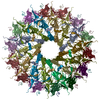 8rt4C  8rt5C 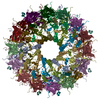 8rt6C 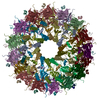 8rt8C 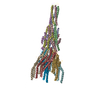 8rt9C 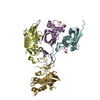 8rtaC 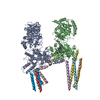 8rtbC 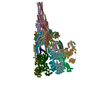 8rtdC M: map data used to model this data C: citing same article ( |
|---|---|
| Similar structure data | Similarity search - Function & homology  F&H Search F&H Search |
- Links
Links
- Assembly
Assembly
| Deposited unit | 
|
|---|---|
| 1 |
|
- Components
Components
| #1: Protein | Mass: 42443.785 Da / Num. of mol.: 16 Source method: isolated from a genetically manipulated source Details: Sequence from conjugative plasmid R388 / Source: (gene. exp.)   #2: Protein | Mass: 29749.586 Da / Num. of mol.: 16 Source method: isolated from a genetically manipulated source Details: Sequence from conjugative plasmid R388 / Source: (gene. exp.)   #3: Protein/peptide | Mass: 5089.048 Da / Num. of mol.: 14 Source method: isolated from a genetically manipulated source Details: Sequence from conjugative plasmid R388 / Source: (gene. exp.)   Has protein modification | Y | |
|---|
-Experimental details
-Experiment
| Experiment | Method: ELECTRON MICROSCOPY |
|---|---|
| EM experiment | Aggregation state: PARTICLE / 3D reconstruction method: single particle reconstruction |
- Sample preparation
Sample preparation
| Component | Name: Conformation-B of the outer membrane core complex from the fully-assembled R388 type IV secretion system Type: COMPLEX / Entity ID: all / Source: RECOMBINANT |
|---|---|
| Molecular weight | Experimental value: NO |
| Source (natural) | Organism:  |
| Source (recombinant) | Organism:  |
| Buffer solution | pH: 7.6 |
| Specimen | Embedding applied: NO / Shadowing applied: NO / Staining applied: NO / Vitrification applied: YES |
| Vitrification | Cryogen name: ETHANE |
- Electron microscopy imaging
Electron microscopy imaging
| Experimental equipment |  Model: Titan Krios / Image courtesy: FEI Company |
|---|---|
| Microscopy | Model: TFS KRIOS |
| Electron gun | Electron source:  FIELD EMISSION GUN / Accelerating voltage: 300 kV / Illumination mode: OTHER FIELD EMISSION GUN / Accelerating voltage: 300 kV / Illumination mode: OTHER |
| Electron lens | Mode: OTHER / Nominal defocus max: 3300 nm / Nominal defocus min: 1500 nm |
| Image recording | Electron dose: 57.5 e/Å2 / Film or detector model: GATAN K3 (6k x 4k) |
- Processing
Processing
| EM software | Name: PHENIX / Version: 1.18.2_3874: / Category: model refinement | ||||||||||||||||||||||||
|---|---|---|---|---|---|---|---|---|---|---|---|---|---|---|---|---|---|---|---|---|---|---|---|---|---|
| CTF correction | Type: PHASE FLIPPING AND AMPLITUDE CORRECTION | ||||||||||||||||||||||||
| 3D reconstruction | Resolution: 2.93 Å / Resolution method: FSC 0.143 CUT-OFF / Num. of particles: 533530 / Symmetry type: POINT | ||||||||||||||||||||||||
| Refine LS restraints |
|
 Movie
Movie Controller
Controller










 PDBj
PDBj




